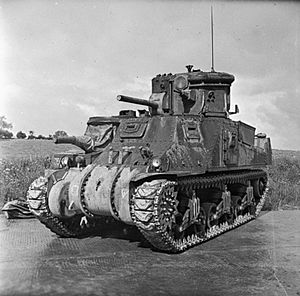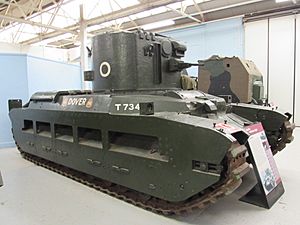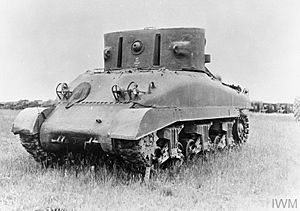Canal Defence Light facts for kids
Quick facts for kids Canal Defence Light |
|
|---|---|

A CDL turret fitted to a M3 Grant tank; the CDL turret is fitted with a dummy gun
|
|
| Type | Non–lethal weapon |
| Place of origin | |
| Service history | |
| Used by |
|
| Wars | World War II |
| Production history | |
| Designer | A V M Mitzakis |
| No. built |
|
The Canal Defence Light (CDL) was a special "secret weapon" used by the British during Second World War. It was a powerful searchlight attached to a tank. The main idea was to light up enemy positions during night attacks. This made it easier for soldiers to see and target them. The bright light also helped to confuse and blind enemy troops. This made it harder for them to shoot back accurately. The name "Canal Defence Light" was a trick to hide what it really was. In the US Army, it was called the "T10 Shop Tractor" for the same reason.
Contents
What Was the CDL?
The idea for the CDL came from a Greek person named Marcel Mitzakis. He created the system in the 1930s. The British War Office saw a demonstration of the device in 1937. They ordered three for testing. The tests finally began in 1940. The War Office then ordered 300 lights to be put on tanks.
The first tank used for a CDL was a Matilda II tank. Its regular turret was taken off. A new round turret was put on instead. This new turret held a very strong searchlight. It also had a machine gun. The searchlight was so bright it was like 13 million candles.
How the Searchlight Worked
The searchlight turret had a spot for an operator. This person had to change the carbon electrodes. These parts burned out as the light was used. The light came out of a small slit. It was only about 2 inches (5.1 cm) wide and 24 inches (61 cm) tall. This small size protected the light from damage in battle.
The light beam spread out wide horizontally. It made a bright area about 34 by 340 yards (31 m × 311 m) at 1,000 yards (910 m) away. The turret could spin all the way around. The light beam could also move up or down by 10 degrees.
The CDL could shine white, blue, or amber light. A special shutter could flash the light on and off. It could flash up to two times every second. Blue light made the CDL tank seem farther away. Blue and amber lights from two tanks could combine to make white light. Flashing the light confused enemy soldiers even more. It did not give their eyes time to get used to the light or the dark.
Upgrading to the M3 Grant Tank
Later, the Matilda tank was replaced by the US M3 Grant. The M3 Grant was a better tank in many ways. It was bigger and had more space inside. It also had stronger armor. The M3 Grant was faster too. It could keep up with other tanks like the Sherman.
The M3 Grant had a 75 mm gun in its main body. It also had a 37 mm gun in a smaller turret. This meant the tank could still fight even with the searchlight turret on. A fake gun barrel was put on the searchlight turret. This made it look like a normal M3 tank. Only one person, the operator, was in the searchlight turret. The tank commander sat next to the driver.
Keeping it a Secret
The CDL project was kept very secret. It was tested in Scotland in 1943. The tests showed it was "too uncertain" to be the main part of an invasion.
American officers, including generals Eisenhower and Clark, saw the CDL in 1942. The US decided to make their own CDL tanks. They used codenames like "Leaflet" for the tank. "Cassock" was the codename for the training program. To keep it secret, different parts were made in different places. The M3 tanks were changed by the American Locomotive Company. They called them "Shop Tractor M10." The turrets were made by another company. The searchlights came from the Corps of Engineers. The final assembly was at Rock Island Arsenal. By the end of 1944, 497 tanks were made.
American crews trained in Fort Knox and in the California-Arizona desert. The six groups of tanks then moved to the UK. They joined the British CDL tanks in Wales.
CDL Tanks in Battle
British and American CDL units went to France in August 1944. The British units were part of the 79th Armoured Division. Some units stayed in the UK. The CDL system was very secret. Surprise was key to using it well. This secrecy made it hard to use. Commanders often did not know about it. So, they did not plan to use it in their attacks.
Many special CDL units were changed to other roles. Some became mine-clearing tanks. Others became regular tank units. This happened instead of letting trained tank crews sit around.
Crossing the Rhine River
Some CDL units were used for the crossing of the Rhine River. One British squadron that still had CDLs was used in the north. Sixty-four American CDL tanks were brought back into use. Their old crews operated them. The US tanks were spread across the First, Third, and Ninth armies.
Protecting the Remagen Bridge
The Allies used CDLs to protect the Ludendorff Bridge after they captured it. This happened during the Battle of Remagen. The Germans tried very hard to destroy the bridge. They even sent frogmen to plant mines underwater. But US Army military police found them. They used Canal Defence Lights to spot and blind the swimmers.
The CDL tanks had armor. This made them better for this job than regular searchlights. German forces held parts of the river's east bank. They shot at the CDL tanks with artillery and small arms. The use of the system here was very much like its name. Later, the battle moved east. The CDLs were used to light up bridges for engineers. The engineers were doing maintenance work. Regular searchlights would have been better, but none were available. Captured German searchlights eventually replaced the CDLs.
Who Used the CDL?
The 11th Royal Tank Regiment was formed in January 1941. It was chosen for the CDL role in May 1941. The unit trained at Lowther Castle in England. It was based at Brougham Hall. It spent 1942 and 1943 in the Middle East. It did not see any fighting there. It came back to the UK in April 1944. It landed in Normandy on August 12, 1944. It did not see action until September 29, 1944. Then, it had to give all its equipment to the 42nd and 49th Royal Tank Regiments. It was retrained to use American amphibious vehicles. These were called the LVT-4, or Buffalo Mark IV by the British Army.
The 42nd and 49th Royal Tank Regiments were mostly inactive for the rest of the war. All three units were disbanded after the war ended.
American soldiers from the 9th Tank Group trained with the Grant CDL tank. They trained at Camp Bouse in the Arizona desert. In 1944, they continued training in Wales before going to Europe.
On November 18, 1944, CDLs helped clear mines. They provided light for flail tanks. These tanks supported infantry in Operation Clipper.
Later Uses of CDL Tanks
Some British tanks were sent to India in 1945. The US Tenth Army asked for CDL tanks for the Battle of Okinawa. But the fighting there was over by the time they arrived.
During the Korean War, searchlights were needed on the battlefield. There was some interest in bringing back a CDL design. This design was for an M4 Sherman tank and started in 1944. But it was decided that regular searchlights were much cheaper. Four groups of soldiers could have normal searchlights for the cost of one CDL tank.
Surviving CDL Tanks

The only surviving CDL-equipped Matilda tank is in England. You can see it at The Tank Museum in Bovington, Dorset. One CDL-equipped M3 Grant tank is in India. It is displayed at the Cavalry Tank Museum in Ahmednagar.
See also
- Camp Bouse US test site.
- Leigh Light
- List of U.S. military vehicles by supply catalog designation SNL G-193


